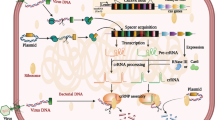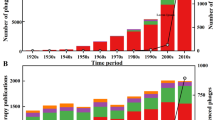Abstract
RNA interference (RNAi) has been extensively used to study gene function in non-model organisms and has the potential to identify parasite target molecules in order to develop alternative treatment strategies. This technology could assist in further development of preventive methods against amoebic gill disease (AGD), the main health problem affecting the Atlantic salmon aquaculture industry in Tasmania (Australia) and now a significant emerging issue in Europe. Using β-actin and EF1-α as candidate genes, we investigated the feasibility of gene knockdown by double-stranded RNA (dsRNA) in Neoparamoeba pemaquidensis, the non-infective strain closely related to the causative agent of AGD, Neoparamoeba perurans. Bacterially expressed dsRNA targeting the selected target genes was administered by soaking (2, 20 and 50 μg/mL) and a time course sampling regime performed. Quantitative real-time PCR analysis showed that candidate genes were successfully downregulated with silencing efficiency and duration both target and dose-dependent. Additionally, β-actin deficient trophozoites unexpectedly transformed into a cyst-like stage, which has not been previously reported in this species. An effective RNAi model system for N. pemaquidensis was validated in the current study. Such findings will greatly facilitate further application of RNAi in the aetiological agent of AGD. To our knowledge, this is the first time that RNAi-mediated technology has been successfully employed in a member of the Neoparamoeba genus.





Similar content being viewed by others
References
Adams MB, Nowak BF (2004) Sequential pathology after initial freshwater bath treatment for amoebic gill disease in cultured Atlantic salmon, Salmo salar L. J Fish Dis 27:163–173
Araujo RN, Santos A, Pinto FS, Gontijo NF, Lehane MJ, Pereira MH (2006) RNA interference of the salivary gland nitrophorin 2 in the triatomine bug Rhodnius prolixus (Hemiptera: Reduviidae) by dsRNA ingestion or injection. Insect Biochem Mol Biol 36(9):683–693
Bridle AR, Carter CG, Morrison RN, Nowak BF (2005) The effect of β-glucan administration on macrophage respiratory burst activity and Atlantic salmon, Salmo salar L., challenged with amoebic gill disease—evidence of inherent resistance. J Fish Dis 28(6):347–356
Crosbie PBB, Bridle AR, Cadoret K, Nowak BF (2012) In vitro cultured Neoparamoeba perurans causes amoebic gill disease in Atlantic salmon and fulfils Koch’s postulates. Int J Parasitol 42(5):511–515
Dunn SR, Phillips WS, Green DR, Weis VM (2007) Knockdown of actin and caspase gene expression by RNA interference in the symbiotic anemone Aiptasia pallida. Biol Bull 212(3):250–258
González-Robles A, Castañón G, Hernández-Ramírez VI, Salazar-Villatoro L, González-Lázaro M, Omaña-Molina M, Talamás-Rohana P, Martínez-Palomo A (2008) Acanthamoeba castellanii: identification and distribution of actin cytoskeleton. Exp Parasitol 119(3):411–417. doi:10.1016/j.exppara.2008.04.004
Hammond SM, Caudy AA, Hannon GJ (2001) Post-transcriptional gene silencing by double-stranded RNA. Nat Rev Genet 2(2):110–119
Hussein AS, Kichenin K, Selkirk ME (2002) Suppression of secreted acetylcholinesterase expression in Nippostrongylus brasiliensis by RNA interference. Mol Biochem Parasitol 122(1):91–94
Kolev NG, Tschudi C, Ullu E (2011) RNA interference in protozoan parasites: achievements and challenges. Eukaryot Cell 10(9):1156–1163
Krautz-Peterson G, Radwanska M, Ndegwa D, Shoemaker CB, Skelly PJ (2007) Optimizing gene suppression in schistosomes using RNA interference. Mol Biochem Parasitol 153(2):194–202
Krautz-Peterson G, Simoes M, Faghiri Z, Ndegwa D, Oliveira G, Shoemaker CB, Skelly PJ (2010) Suppressing glucose transporter gene expression in Schistosomes impairs parasite feeding and decreases survival in the mammalian host. PLoS Pathog 6(6):e1000932
Lima PC, Harris JO, Cook M (2013) Exploring RNAi as a therapeutic strategy for controlling disease in aquaculture. Fish Shellfish Immunol 34(3):729–743
Liu S, Ding Z, Zhang C, Yang B, Liu Z (2010) Gene knockdown by intro-thoracic injection of double-stranded RNA in the brown planthopper, Nilaparvata lugens. Insect Biochem Mol Biol 40(9):666–671
Ongvarrasopone C, Roshorma Y, Panyima S (2007) A simple and cost effective method to generate dsRNA for RNAi studies in invertebrates. Sci Asia 33:35–39
Orii H, Mochii M, Watanabe K (2003) A simple “soaking method” for RNA interference in the planarian Dugesia japonica. Dev Genes Evol 213(3):138–141
Parsons H, Nowak B, Fisk D, Powell M (2001) Effectiveness of commercial freshwater bathing as a treatment against amoebic gill disease in Atlantic salmon. Aquaculture 195(3–4):205–210
Pfarr K, Heider U, Hoerauf A (2006) RNAi mediated silencing of actin expression in adult Litomosoides sigmodontis is specific, persistent and results in a phenotype. Int J Parasitol 36(6):661–669
R Development Core Team (2007) R: A language and environment for statistical computing. R Foundation for Statistical Computing, Vienna, Austria. http://www.R-project.org. Accessed 11 May 2012
Solis CF, Santi-Rocca J, Perdomo D, Weber C, Guillén N (2009) Use of bacterially expressed dsRNA to downregulate Entamoeba histolytica gene expression. PLoS ONE 4(12):e8424
Sukno SA, McCuiston J, Wong MY, Wang X, Thon MR, Hussey R, Baum T, Davis E (2007) Quantitative detection of double-stranded RNA-mediated gene silencing of parasitism genes in Heterodera glycines. J Nematol 39(2):145–152
Acknowledgments
The authors would like to thank Dr David Cummins for their valuable suggestions and comments on the manuscript. Authors also thank Min Rao (CSIRO Animal, Food and Health Sciences) for kindly providing L4440 plasmid vector and E. coli HT115 strain and Russell McCulloch (CSIRO Animal, Food and Health Sciences) for the assistance with microscopy. This work formed part of a project of the Australian Seafood Cooperative Research Centre (CRC), and received funds from the Australian Government’s CRCs Programme, the Fisheries Research & Development Corporation and other CRC Participants.
Author information
Authors and Affiliations
Corresponding author
Rights and permissions
About this article
Cite this article
Lima, P.C., Botwright, N.A., Harris, J.O. et al. Development of an In Vitro Model System for Studying Bacterially Expressed dsRNA-Mediated Knockdown in Neoparamoeba genus. Mar Biotechnol 16, 447–455 (2014). https://doi.org/10.1007/s10126-014-9561-4
Received:
Accepted:
Published:
Issue Date:
DOI: https://doi.org/10.1007/s10126-014-9561-4




